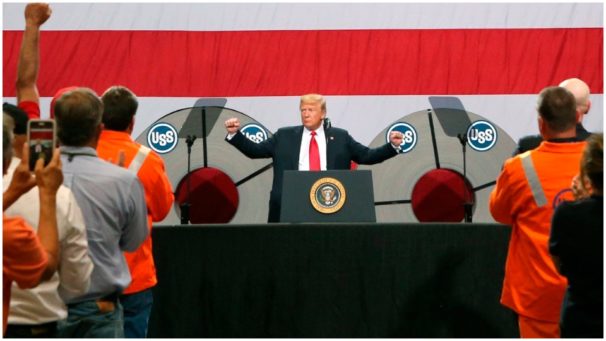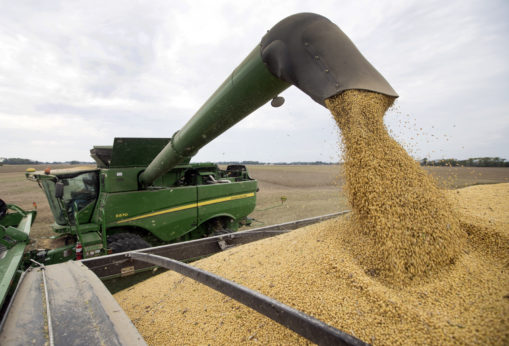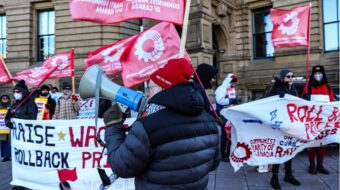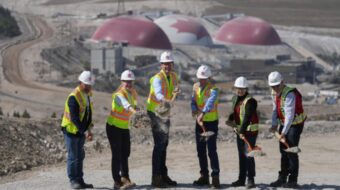
Donald Trump voiced the real concerns of many Americans when he spoke of the need to bring jobs to communities and to end unfair trade deals. By blocking the Trans-Pacific Partnership, pushing a re-negotiation of NAFTA, and increasing tariffs on a range of imports, Trump has appeared to finally take seriously the needs of unemployed and underemployed workers.
Some unions have been calling for tariffs for years, most notably the United Steelworkers. While Obama ran in 2008 on a promise to renegotiate NAFTA, he never did so, and in fact became a relentless proponent of expanding “free trade.”
So is Trump the worker’s hero? Will increased tariffs return jobs to the U.S.? The left has been weak on this issue. On the one hand, we need to take economic development and job creation seriously. Workers are suffering. Even though official unemployment rates are low, more and more of the jobs people hold are low-wage, insecure, non-union, and dead-end.
The left lacks a real program to address the real concerns of those impacted by trade deals. We need to better understand the history of tariffs and trade, and we need an international vision for economic development.
What are tariffs?
Most rich countries have used import tariffs as a way to develop their own industries. Alexander Hamilton argued in the late 1700s for using tariffs to develop “infant industries” until they grew large enough to compete in a global market. In general, the idea was to allow raw materials in at a lower tax. The import tariff on intermediate or finished goods was much higher. This allowed manufacturers to import cheap inputs from other countries, and then manufacture the items domestically. Most of the profit in a good comes in the production stage. The goal for countries is to be able to “move up the economic ladder,” where they can go from raw material exporters (at low profit rates), to finished goods exporters (at much higher profit rates).
Marx explained this process through the concept of socially-necessary labor time, or the average amount of labor time needed for a worker to produce a good for exchange. There is relatively little labor time needed to harvest a peanut and more labor time needed to manufacture peanut butter.
For example, in the 1400s Britain was making money by exporting raw wool, but Henry VII understood that there were much greater profits for those who converted the raw wool into clothing. He took a number of steps, including increasing the tax on raw wool exports and then banned the export of unfinished cloth. This forced British producers to process the wool and cloth into finished clothing. Only then did Britain lower tariffs. When Robert Walpole came in as British prime minister in 1721, he significantly raised tariffs on manufactured imports such as clothing and metal works, and reduced or eliminated import tariffs for primary commodities produced in the colonies, including wood, tobacco, clay, and cotton.
Marx explained this process through the concept of socially-necessary labor time, or the average amount of labor time needed for a worker to produce a good for exchange.
The United States relied heavily on high import tariffs on a range of goods, for many decades. According to the economist Ha-Joon Chang, the U.S. had some of the highest tariffs in the world from 1816 to 1945. (This can of course create strong tensions between different sections of the ruling class. For example, Southern plantation owners wanted low tariffs so that they could easily export raw cotton and import manufactured goods. Northern manufacturers wanted high tariffs on manufactured imports.)
But tariffs were not the only tool governments used. Chang points out that every rich country became rich by using a range of government interventions. Tariffs are just one tool. Other tools include direct subsidies to firms, public investment in infrastructure that allows industries to develop and transport goods, public investment in research and development, public schools to train workers, financial regulations, banking systems to generate savings available for investment, nationalization of industries, and more. Governments have also used more insidious tools to develop their economies, including war, colonization, industrial espionage, and the trade in human beings forced into slave labor.

Many economists from a range of perspectives have argued the world as a whole benefits from “free trade”: the idea that countries should be able to exchange goods and services without tariffs or other disincentives or barriers. The “free trade” school of thought has dominated economics since WWII. The General Agreement on Tariffs and Trade (GATT) was established just after WWII as a diplomatic forum where states could meet and agree to reduce tariffs. In 1995, the World Trade Organization (WTO) was formed, with a mandate to govern the rules of trade between states, with the “goal of ensur[ing] that trade flows as smoothly, predictably, and freely as possible.”
Alongside the WTO, countries signed “free trade” agreements and bilateral or multilateral investment treaties, designed to reduce tariffs further, and particularly to reduce other “barriers” to trade. The U.S. signed its first free trade agreement in 1985, with Israel, and has since signed bilateral or multilateral agreements with 19 other countries.
The U.S. now has a highly complex tariff schedule. There are three different rates of duty—the general rate, a “special” for “free trade” or “generalized system of preference” partners, and a third rate that applies to Cuba and North Korea. Some products are free: there is no import tariff. Fresh plantains, for example, can come in with no tariff even from Cuba or North Korea. Dried plantains, however, require some processing. They have a 1.4 percent tariff for the general rate, free for the special rate, and 35 percent for our “enemy” countries. Chainsaw blades have a 7.2 percent general tariff, free for the special rate, and 60 percent otherwise. Meanwhile, circular saw blades are free for the general and special rate, and 25 percent otherwise.
All of this highlights the reality that tariffs are greatly influenced by political processes as much as economic ones. Employer associations, powerful corporations, members of Congress, unions, and consumers have all lobbied to set tariff rates for each of the tens of thousands of products. There is no other way to explain why tariff rates differ for forks versus spoons, or for almonds versus pistachios versus pecans versus chestnuts.
Another political consideration is how other countries respond to our tariffs. If we raise tariffs on Chinese steel, China might raise tariffs on our wheat. Since the end of World War II, most Western countries have agreed to keep tariffs low and avoid this sort of scenario. In fact, tariffs have been so low that “free trade” agreements haven’t lowered them much; the difference between, say, 1.4 percent and zero is trivial.
This raises the question: why has there been so much uproar about free trade agreements, since at least the “Battle of Seattle” in 1999? The answer is that modern “free trade” agreements aren’t really about tariffs. Rather, they’re about loosening restrictions on flows of international investment, which makes it easier for Western companies to offshore jobs (and hide their profits from the tax authorities). (For more on this, see this comic).
Trade agreements have also been about lowering “non-tariff barriers to trade.” These include things large sections of the population support, such as environmental protections, labor laws, or licensing restrictions (such as against genetically modified seeds). Many of these protections have been weakened or voided in the name of “free trade.”
Should we support increased tariffs to save jobs?
It is impossible to say for sure why Trump is pushing for tariffs and some better terms for labor in the new NAFTA, but it is highly unlikely he is concerned with worker rights. His appointments for Secretary of Labor and the Supreme Court alone are evidence that that he is out to break unions and reduce worker wages and benefits.
Trump’s other great campaign promise to workers was to enact large infrastructure programs that would create jobs, but that has yet to happen. While spending tens of millions on military parades and Mar-a-Lago weekends and passing a $1.5 trillion tax cut, Trump has failed to bring his infrastructure proposal to light.
Instead, the Trump policy seems designed to redirect real worker frustrations about jobs and wages into anger at other countries (and immigrants), rather than at corporations.
Trump presents himself as the only politician willing to stand up for the blue-collar worker—and this is easy to do, because so few politicians have actually been champions of the working class. Action on tariffs and trade deals has won him support among certain voters and even union leaders who have felt long ignored.
The new NAFTA language is interesting because it contains a number of advances on labor issues, including eliminating some of the controversial protections for investors and a requirement that at least 45 percent of an automobile, or 40 percent of auto parts be made by a worker earning at least $16 per hour. This seems a clear play to gain support from the United Auto Workers and rustbelt workers.
Yet even auto industry analysts don’t think the proposal is likely to save jobs. Just ask Kristin Dziczek, from the Center for Automotive Research, who said, “The big upshot is there’s nothing in this agreement that looks like lots of jobs are coming to the U.S.”
But Trump’s stance on tariffs and trades appeals to workers who have lost their jobs and are looking for hope anywhere they can. It also plays with some of his supporters who are motivated more by nationalism and racism than economic concerns, so the fact that tariffs won’t bring back many jobs doesn’t matter to them. And while tariffs are a real problem for some of the capitalist class, not all are directly impacted, and for all of Trump’s talk of NAFTA re-negotiation, his plans will leave the bigger problems with “free trade” (unregulated cross-border money flows and erosion of environmental and labor protections) untouched.
So what’s really going on?
Here are a couple of key points that help us evaluate what to think about tariffs.
First, economic development is a complicated subject. No one has figured it out, and no one has the magic solution. Tariffs have in fact been a useful tool for economic development and job creation but they are only one tool. Tariffs on their own can backfire if they are used to protect corrupt or inefficient employers, or dying industries. They can also backfire if they provoke other countries to impose retaliatory measures—as is happening with Trump’s trade war with China.
Second, the package of tools that rich countries used to become rich have mostly been disallowed for developing economies under our trade and investment agreements. We do not allow partner countries to use tariffs or subsidies to develop their infant industries. We push them to privatize publicly-owned businesses. We do not allow them to keep our goods or our businesses out (imagine what Japan’s situation would be today if Ford and GM had been able to freely sell cars there or open auto plants there; Toyota, Mitsubishi, and Nissan would never have had a chance). All the while we continue to use a range of these tools ourselves. For example, the Mexican government was forced to stop subsidizing Mexican corn growers under NAFTA, while opening their markets to U.S. agriculture, even though U.S. food is heavily subsidized (subsidies that violate every supposed principle of “free trade”). U.S. food flooded the Mexican market, undercutting Mexican farmers and driving them off the land (bizarrely, many wound up moving north to grow food in the United States to be sent back to Mexico).
U.S. unionists talk of unfair behavior in China: dumping, fixed currency rates, and intellectual property law violations. And these are real issues. But U.S. corporations engage in a wide range of unfair activities as well, often supported by or protected by the U.S. government. Any talk of tariffs should be situated in this context.
It can be hard to frame demands in an internationalist rather than nationalist framework. But in this moment of rising hate groups, anti-immigrant and nationalist movements, it is crucial that the left not be pulled into making alliances around nationalist policy.
So yes, let’s reform our economic relations with other countries. U.S. trade and investment policy have been disastrous—damaging economies elsewhere, exacerbating global inequality and destabilizing the world economy, which has rebounded back on us. Let’s talk about trade and economic development policies that allow workers to find living wage jobs in their own home countries. It can be hard to frame demands in an internationalist rather than nationalist framework. But in this moment of rising hate groups, anti-immigrant and nationalist movements, it is crucial that the left not be pulled into making alliances around nationalist policy.

Third, tariffs are not the only economic development tool. People may blame outsourcing or unfair trade, but in fact there are many policy options available to us to try right now to create good jobs. For example, one argument for steel tariffs was based on national security. But if security is really our concern, it is a mistake to leave vital production of things like steel, oil, medicine, and food in the hands of unaccountable private corporations. Create public entities that can do this!
There is a wide range of policy options that we could pursue to create jobs, and to make bad jobs into better ones. These include:
– Raise taxes on the rich and corporations; use the money to bring back the federal and state jobs cut in recent years. Re-hire people to run our libraries, state parks, mail service, trains, and more.
– Public investment in education to expand the number of teacher jobs and raise salaries for educators.
– Real public investment in rebuilding our bridges and trains and tunnels.
– Instituting universal health care would have many benefits, including greatly reducing the cost of production for U.S. manufacturers.
– Reform labor laws so that is it easier for workers to join unions. This would allow workers to convert many of the current low-wage, sometimes dangerous jobs, to good ones.
– Free higher education! This allows more students to gain education and training, and it is an investment in research and development.
Our demands must focus on ways to create jobs that also undercut the power of multi-national corporations to pit workers against one another. The principle must be job creation built on solidarity—with other workers, with workers in other industries, and with workers overseas—not competition.
Thanks to Michael Goodwin, Adam Hefty, and Jonathan Kissam for input on this article.
This article was originally published at Organizing Upgrade.









